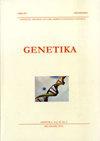豇豆(Vigna unguiculata L. Walp.)基因型的形态和分子特征
4区 农林科学
Q3 Agricultural and Biological Sciences
引用次数: 0
摘要
豇豆[豇豆]Walp。是一种豆科植物,是人类已知的最古老的作物之一,生长在热带和亚热带地区。豇豆种子营养价值高,蛋白质含量高(20-25%)。尽管遗传多样性和种质鉴定在豇豆育种中的应用具有重要意义,但尚未得到充分利用。因此,利用12个形态特征和6个多态微卫星/简单序列重复(SSRs)标记分析了38个豇豆基因型的遗传多样性。采用UPGMA算法和Gower?12个形态性状的差异值在0.0601 ~ 0.5589之间。结果显示,CGD 1246和CGD 1311 (Gower?基因型最相似的是GC 1501和GC 1601(高尔?S距离:0.0601)。在分子表征方面,共检测到14个扩增子,每个位点平均有2.33个等位基因,扩增子的数量从2到3不等。多态信息含量(PIC)和杂合度的平均值分别为0.319和0.399,是衡量豇豆基因型中可用标记多态性水平研究效率的指标。总共考虑了224个扩增子来推导出Jaccard?s相似矩阵用于构建树形图(有六个聚类)和二维主成分分析(PCA)图。这些形态特征和SSR标记可用于豇豆基因型的多样性分析和鉴定。在豇豆的群体/基因型发展中,可以利用个别性状本身表现良好的基因型来改进该性状。这将为植物育种家在豇豆育种计划中选择亲本以发展群体提供信息。本文章由计算机程序翻译,如有差异,请以英文原文为准。
Morphological and molecular characterization of cowpea (Vigna unguiculata L. Walp.) genotypes
Cowpea [Vigna unguiculata (L.) Walp.], is a legume and one of the most ancient crops known to man and grown in tropical and subtropical regions. Cowpea seeds have a high nutritional value containing high amount of protein (20-25%). Despite of its importance, the utilization of genetic diversity and germplasm characterization in cowpea breeding program has not been fully exploited. Therefore, twelve morphological characters and six polymorphic microsatellite/simple sequence repeat (SSRs) markers were used to analyze genetic diversity in thirty-eight cowpea genotypes. The dendrogram was constructed using UPGMA algorithm and Gower?s dissimilarity values (ranged from 0.0601 to 0.5589) derived from twelve morphological characters. It was grouped in seven clusters showing the most diverse genotypes were CGD 1246 and CGD 1311 (Gower?s distance: 0.5589) and the most similar genotypes were GC 1501 and GC 1601 (Gower?s distance: 0.0601). In molecular characterization, a total of 14 amplicons were detected with a ranged from two to three with an average 2.33 alleles per loci. The mean values of polymorphic information content (PIC) and heterozygosity was 0.319 and 0.399, respectively which are measures of the efficiency of markers for studying polymorphism level available in the cowpea genotypes. Total 224 amplicons were considered for to derive Jaccard?s similarity matrix for the construction of dendrogram (having six clusters) and 2-D PCA (Principal Component Analysis) plot. The morphological characters and SSR markers can be used in diversity analysis and characterization of cowpea genotypes. The per se performing genotypes for individual character can be exploited in population/genotype development of cowpea for the improvement of that particular character. This will provide information to plant breeders for selection of parents to develop populations in cowpea breeding programs.
求助全文
通过发布文献求助,成功后即可免费获取论文全文。
去求助
来源期刊

Genetika-Belgrade
AGRONOMY-GENETICS & HEREDITY
CiteScore
1.80
自引率
0.00%
发文量
1
审稿时长
6-12 weeks
期刊介绍:
The GENETIKA is dedicated to genetic studies of all organisms including genetics of microorganisms, plant genetics, animal genetics, human genetics, molecular genetics, genomics, functional genomics, plant and animal breeding, population and evolutionary genetics, mutagenesis and genotoxicology and biotechnology.
 求助内容:
求助内容: 应助结果提醒方式:
应助结果提醒方式:


